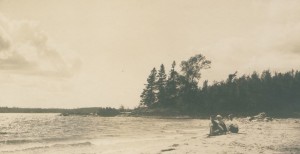Lake of the Woods was carved into the granite of the Canadian Precambrian Shield by receding glaciers over 10,000 years ago. The underlying bedrock that the present lake sits upon is among the oldest of geological formations to be found on earth. The area was originally covered by the mammoth Lake Agassiz which covered much of Northwestern Ontario, Manitoba and northern Minnesota. However, over time, these glacial waters receded leaving Lake of the Woods as we know it today.
The Lake of the Woods area has a rich history that dates back to 7000 BC when the Palaeo Indians hunted prehistoric large game. Evidence of the early Cree is found on many ancient pictographs that have survived for more than 500 years. (Many of these paintings can be seen on the rock faces that are found throughout the lake system.) The native’s referred to the north end of the lake as Wauzhushk Onigum, which literally translated means “portage to the country of the muskrat.”
The first white man to see the lake was Jacques de Noyen, a 20 year old French explorer, in 1668. He was followed by the French explorer De La Verendrye who built Fort St. Charles in 1732 and surveyor David Thompson who first visited in 1797.
 The early 1800’s saw a rapid increase in settlement with the arrival of many traders and missionaries. The Hudson Bay Trading Company established a post on the Winnipeg River in 1836, and shortly thereafter moved to the Lake of the Woods, becoming the town’s first building.
The early 1800’s saw a rapid increase in settlement with the arrival of many traders and missionaries. The Hudson Bay Trading Company established a post on the Winnipeg River in 1836, and shortly thereafter moved to the Lake of the Woods, becoming the town’s first building.
Commercial fishing began to take root during the early 1890’s, and in 1893, Lake of the Woods was deemed the world’s largest source of caviar. Around this time, a gold rush began to take shape that marked the beginning of local mining. (These two major gold rushes proved to be every bit as big as the Klondike era!)
The Backus-Brooks paper mill began operations in Kenora in 1923 and has been through several different owners since that time. Today it is owned by Abitibi Consolidated and continues to be the town’s major employer.
